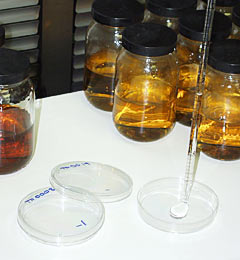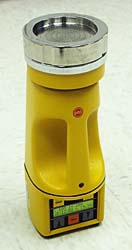Sampling & Testing
 Since mold spores and any toxins they produce are microscopic, it is often not possible to detect the presence of mold contamination simply by sight or smell. Although visible mold growth is indicative of severe contamination that must be eliminated, the absence of such obvious contamination does not mean that a problem does not exist. Invisible mold spores in the air, HVAC system, carpeting, etc., can cause severe health problems even if they are not actively growing.
Since mold spores and any toxins they produce are microscopic, it is often not possible to detect the presence of mold contamination simply by sight or smell. Although visible mold growth is indicative of severe contamination that must be eliminated, the absence of such obvious contamination does not mean that a problem does not exist. Invisible mold spores in the air, HVAC system, carpeting, etc., can cause severe health problems even if they are not actively growing.
To determine if a mold problem exists, a variety of sampling techniques can be employed. Air sampling for mold spores, as well as surface, bulk, and swab sampling, can be performed to provide a thorough assessment of the indoor environment. Measurement of the temperature and relative humidity of the indoor air, as well as determining the moisture levels present in wood, gypsum, and concrete substrates may also be performed. Although not all of these methods may be used in all situations, it is important that the expert doing the assessment have the expertise necessary to be able to properly determine which tests should be performed for the environment in question. Once the results of the sampling are known, any mold problems that may exist in the indoor environment in question can be identified and a plan for remediation can be established.
 Once the remediation of the mold has been completed, it is recommended that follow-up testing of the area that was remediated be performed to ensure the remediation was properly done, and the mold problem was abated. The follow-up testing will determine not only if the conditions for mold growth have been eliminated, but also if the excessive levels of mold present in the contaminated area have been eliminated. This will help to ensure that the likelihood of a recurrence of the mold problem in the area in question remains small.
Once the remediation of the mold has been completed, it is recommended that follow-up testing of the area that was remediated be performed to ensure the remediation was properly done, and the mold problem was abated. The follow-up testing will determine not only if the conditions for mold growth have been eliminated, but also if the excessive levels of mold present in the contaminated area have been eliminated. This will help to ensure that the likelihood of a recurrence of the mold problem in the area in question remains small.
Of critical importance with regard to the sampling, testing, and analysis of the indoor environment is the use of experts with significant experience in this area. It is of the utmost importance that the persons doing the sampling have the technical background and expertise to accurately evaluate the situation and utilize proper sampling technique to maintain the sample integrity. Poor sampling technique or lack of knowledge about what types of samples should be taken will inevitably lead to erroneous results. Similarly, it is important to ensure that the laboratory doing the analysis of the samples have the appropriate experience in handling environmental mold samples, and that they are using methodology in compliance with recommendations put forth by the AIHA and the ACGIH. A laboratory with AIHA EMPAT accreditation is recommended.